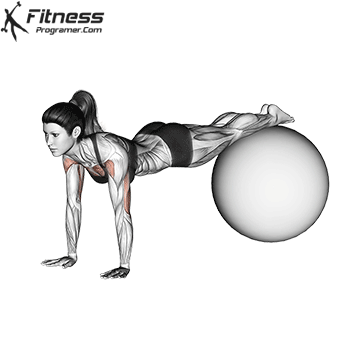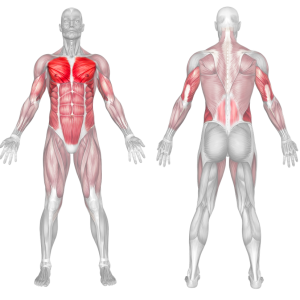Stability Ball Decline Push-Up Overview
The Stability Ball Decline Push-Up combines traditional push-up mechanics with a stability challenge. Elevating your feet on a stability ball increases the intensity for your chest, shoulders, and triceps while engaging your core for balance. This advanced variation is an excellent addition to any upper body or functional fitness routine.
How to Perform the Stability Ball Decline Push-Up

Setup
Choose the Right Stability Ball
- Use a properly inflated stability ball that supports your weight without excessive wobbling.
Get into Position
- Place the ball behind you and kneel on the floor. Position your hands shoulder-width apart on the ground in a push-up stance.
Elevate Your Feet
- Place your feet or shins on the stability ball. Adjust your position so your body forms a straight line from head to heels.
Execution
Lower Your Chest
- Bend your elbows to lower your chest toward the floor, keeping your core engaged and body aligned.
Pause at the Bottom
- Hold briefly at the lowest point without letting your chest touch the floor.
Push Back Up
- Press through your palms to return to the starting position while maintaining control over the stability ball.
Repeat
- Perform the desired number of repetitions with slow and controlled movements.
Tips for Proper Form
- Engage Your Core: Keep your abs tight to maintain stability and prevent sagging hips.
- Slow Movements: Avoid rushing; focus on smooth, deliberate reps to maximize effectiveness.
- Adjust Ball Placement: Position the ball closer to your feet for added difficulty or near your knees for more stability.
- Neutral Spine: Keep your head aligned with your spine throughout the exercise.
Common Mistakes
Sagging Hips: Engage your glutes and core to keep your body straight.
Rushing the Movement: Move slowly to maintain balance and control.
Improper Hand Placement: Ensure your hands are directly under your shoulders for support.
Ball Slipping: Use a non-slip surface or perform the exercise near a wall for added safety.
Benefits of the Stability Ball Decline Push-Up
Enhanced Chest Activation
- The decline position shifts more load to the upper chest for targeted muscle development.
Core Stability
- Balancing on a stability ball activates deep core muscles, improving overall stability.
Improved Shoulder Strength
- The elevated position increases the demand on the shoulders for added strength and endurance.
Functional Fitness
- Mimics real-world movements requiring balance and coordination.
Progressive Difficulty
- Adds a new level of challenge for those ready to advance from standard push-ups.
Stability Ball Decline Push-Up: Muscles Worked

